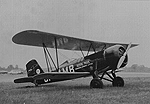As the small bush companies grew, they became the precursors of Canada's
modern airlines. Western Canada Airways, formed by Winnipeg businessman
James A. Richardson in 1926, eventually became Canadian Pacific Airlines
and more recently Canadian Airlines International. In 1937, the Canadian
government established Trans-Canada Air Lines (TCA), now known as Air Canada,
to provide transcontinental air transport service in this country.
The museum's collection includes a Boeing
247D. This aircraft was the world's first modern airliner.
All the most up-to-date developments of the day were put into this machine.
The prototype flew in 1933. It combined greater comfort and safety with
much improved cruising range and speed. Advertised as the Club Car of the
air it provided the comfort of sound-proofing, air-conditioning, reading
lamps and, with a flight attendant for ten passengers, all the care and
attention you could want.
It had an automatic pilot, could fly safely on one engine and had a
retractable landing gear. The 247D made all other airliners obsolete. It
even flew faster than the military aircraft of its time.
The Lockheed 10A Electra
was Trans-Canada Airlines' first brand-new airplane delivered in 1937.
TCA , now called Air Canada, started up in 1937 with two second-hand Electras
and a Stearman Model 4
mailplane like the one to the left of the Electra.

Stearman 4EM Junior Speedmail
© National Aviation Museum (Canada)
One of the Electras was used for pilot training. Many would-be airline pilots had only flown by day, by sight and by the seat of their pants. In cloud or fog they gauged the angle of the aircraft by the pressure of the seat against their bodies. Without visual reference points, a pilot may feel the aircraft is straight and level when it is really going into a turn or even a dive.
Imagine yourself in the two-seater cockpit, your windows covered with
a canvas hood. Curtains around you block any view. You are taking off blind
when suddenly one of the engines cuts out. It was in the Electra that many
of TCA's first pilots learned instrument flying, night flying and radionavigation.
And, for emergency training, the instructors did turn off one of the engines,
often during take-off. When regular TCA passenger service began in 1939,
the travellers, welcomed by the stewardess at the bottom of the ramp, were
in expert hands.
That year 1,000 young women applied for about 12 flight attendant positions.
Pat Eccleston, one of TCA's first attendants...
The luxury, performance, and safety improvements, plus a bigger passenger cabin, were incorporated into the Douglas DC transport, culminating in 1936 with the appearance of the Douglas DC-3, one of aviation's all-time greats.
The first transport that could operate at a profit without subsidies, the remarkable DC-3, became the backbone of commercial airliners around the world. The aircraft on display is, appropriately, TCA's first DC-3. Acquired by the airline in 1945, it flew for 38 years before being donated by Goodyear Canada.